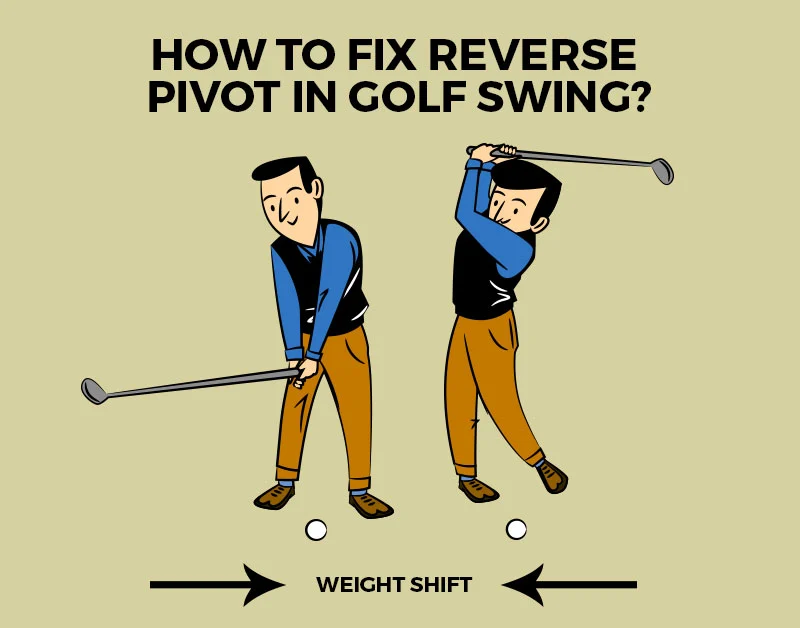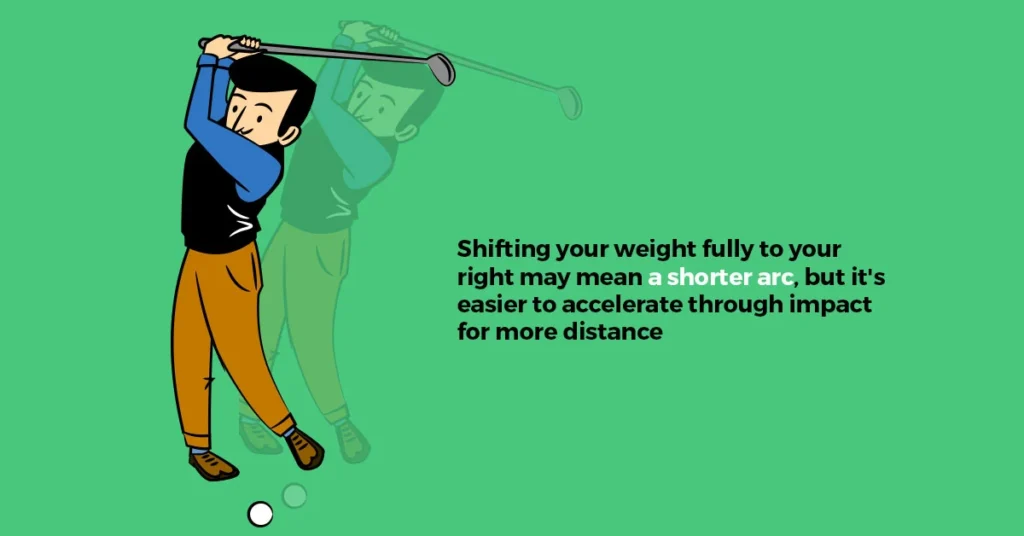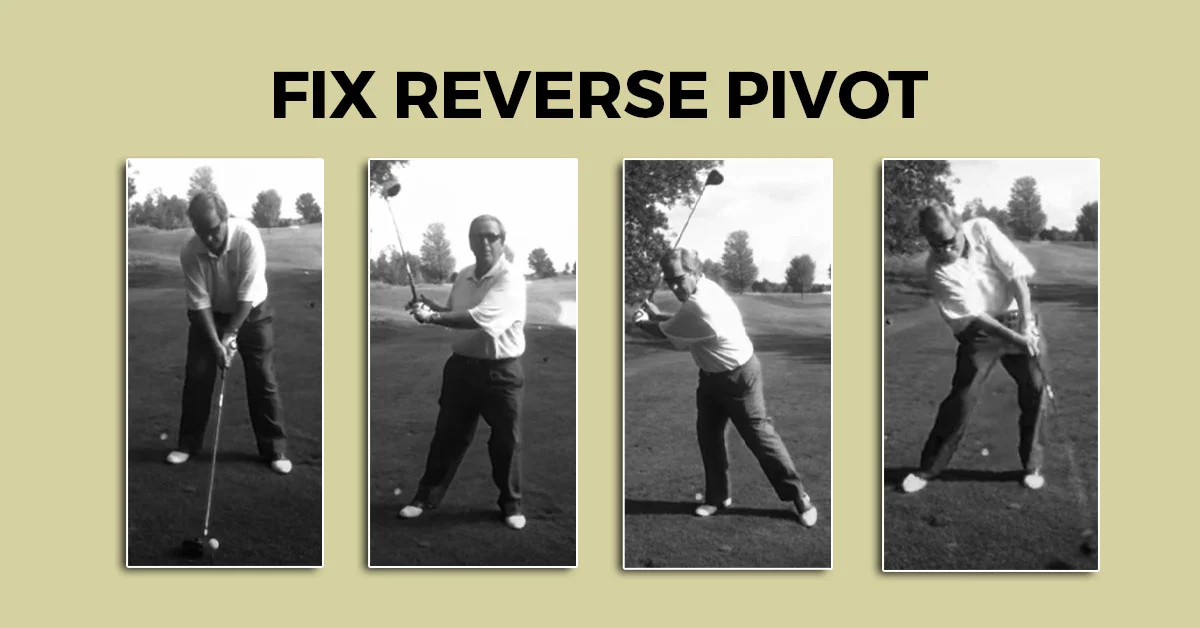- Introduction
- Understanding the Reverse Pivot
- What is a Reverse Pivot?
- Characteristics of Reverse Pivot:
- The Ideal Weight Distribution:
- The Dynamics of a Proficient Golf Swing:
- Common Problems Associated with Reverse Pivot:
- Step-by-Step Correction Techniques for How to Fix Reverse Pivot in your Golf Swing:
- Expert Drills: Advice from Jon Woodroffe
- Types of Reverse Pivot:
- Addressing the Reverse Spine Angle What Is It?
- Correction Strategies
- Identifying Reverse Spine Angle
- Conclusion
Introduction
Golf is often compared to a well-choreographed dance due to its complex combination of skill and technique. However, a common swing error known as the “reverse pivot” can upset this harmony and degrade play. With the aid of this thorough guide by our experienced golfers, you will be able to comprehend and fix the reverse pivot in your golf swing by improving the game on the course.
Understanding the Reverse Pivot
More than just a technical error, the reverse pivot represents a breakdown in the organic flow and balance that are essential to golf. This mistake not only degrades the quality of each shot individually, but it can also set off a series of problems that impair play as a whole. It has become a focal point for golf instructors and players alike due to its prevalence among amateur and professional players.
Recognizing and fixing the reverse pivot is about more than just making a single shot better; it is about restoring the complex balance that golf requires. For golfers of all skill levels, from novices to experienced players wishing to improve, our mission is to provide a guiding light.
This guide aims to improve the golfer’s performance by addressing the reverse pivot and making sure that every swing positively contributes to the smooth, rhythmic dance that is a successful game of golf. Whether you are practicing at the driving range or playing competitively, the tips and strategies offered here will help you achieve a more efficient, powerful, and well-balanced swing. You may like to read our article on How To Stop Swaying In Golf Swing?
What is a Reverse Pivot?

The reverse pivot is a prominent fundamental flaw in the golf swing that is characterized by an incorrect shift in the player’s body weight during the swing. This weight distribution mismatch is not merely an error; rather, it deviates significantly from the optimal golf swing mechanics.
A proficient golfer’s weight shifts in a smooth and efficient manner, reflecting the rhythm and flow of the swing itself. This is a standard shot. This weight transfer, however, happens in the opposite way during a reverse pivot than what is necessary for a strong, precise shot.
When a golfer swings back, the weight incorrectly moves to the front foot rather than the back foot. On the other hand, the weight shifts back to the rear foot during the downswing when it should be going forward to the front foot.
This unnatural movement pattern throws off the rhythm and balance of the swing and has a significant impact on shot power and accuracy. Due to the unusual strain it puts on the body, the reverse pivot can cause a variety of issues, including decreased shot distance, uneven ball striking, and even an increased risk of injury.
Golfers looking to raise their game must comprehend and correct a reverse pivot. Relearning and practicing proper weight transfer throughout the swing are necessary. This is a fundamental skill that is the foundation of effective and potent golf shots. Golfers can improve their performance on the course and develop a more stable, balanced, and effective swing by correcting this flaw.
Characteristics of Reverse Pivot:
The golfer experiences multiple swing inefficiencies when they execute a reverse pivot because their body weight shifts against the intended pattern.
Backswing
The ideal backswing motion involves transferring the weight to the back foot. But this is also the point at which the first important mistake happens in a reverse pivot. The weight incorrectly shifts towards the front foot rather than the back foot. This misplacement of weight during the backswing sets the stage for a cascade of issues in the rest of the swing.
Downswing
It is during the downturn that the negative effects of the reverse pivot become more apparent. In order to generate power and improve shot accuracy, the golfer’s weight should smoothly transition forward to the front foot during the downswing in a proper swing.
On the other hand, in a reverse pivot, the back foot gains weight. This unusual shift that happens during the downswing disturbs the natural flow and balance of the shot, compromising its power and accuracy.
The Ideal Weight Distribution:

Understanding the ideal weight distribution is crucial for correcting a reverse pivot. Here’s what it should ideally look like:
Starting Position
The weight of both feet should be equally distributed at the start of the swing. The basis for a strong and precise swing is this balanced stance.
During the Backswing
The weight should gradually transfer to the back foot as the backswing begins. This change in direction enables the player to build up momentum in anticipation of a powerful and deliberate downswing.
During the Downswing
The front foot must receive the weight transfer smoothly and promptly during the downswing. In order to produce the required power and guarantee that the clubhead strikes the ball as effectively as possible, this forward shift is essential.
Follow-Through
The majority of the player’s weight should land on the front foot by the end of the swing. Maintaining balance and control is made easier when this weight distribution is followed through on, as it guarantees the ball receives all of the energy transferred to it.
The Dynamics of a Proficient Golf Swing:
An expert golf swing is a carefully calibrated series of motions that all work together to maximize shot power and efficiency. A deliberate adjustment in weight distribution at various swing phases is one of the essential components.
Equitable Weight Distribution at the Beginning: The swing starts off with both feet bearing the same amount of weight. To ensure a steady and controlled start, adopt this balanced stance.
Weight Shifts to the Back Foot During the Backswing: The weight should shift smoothly to the back foot as the club is brought back. The golfer can “load” energy with this shift, preparing for a strong downswing.
Weight Moves Forward to the Front Foot During the Downswing: The front foot shifts weight quickly and smoothly during the downswing. In order to exert force and direct it through the ball at impact, this movement is necessary.
Common Problems Associated with Reverse Pivot:
A number of serious issues arise from the reverse pivot’s substantial departure from this ideal sequence:
Insufficient Power Transfer: The ineffective transfer of power to the ball is one of the main problems with a reverse pivot. The energy produced during the swing is not fully transferred at the point of impact because the weight does not shift correctly. This inefficiency may cause the shot to lose distance and lose total power, which will alter the shot’s trajectory and reach.
Poor Shot Quality: “Thin” shots are frequently the result of improper weight distribution during the reverse pivot. Incorrectly shifting weight forward during the downswing can cause the club to make contact with the ball at an unfavorable angle.
Shots that are thin and lack the appropriate loft and control are the result of the swing’s lowest point falling behind the ball. This influences the shots’ accuracy and consistency in addition to their trajectory and distance.
Step-by-Step Correction Techniques for How to Fix Reverse Pivot in your Golf Swing:
Reverse pivot correction calls for a methodical approach that emphasizes the core elements of the golf swing. Here are important actions to help resolve this frequent problem:
1. Understanding Ball Lift Mechanics
- Avoid Scooping: The idea that you must “scoop” the ball into the air is a frequent misconception. When the golfer tries to lift the ball with the club, this frequently results in a reverse pivot.
- Have faith in the club’s design: contemporary clubs are made to raise the ball just enough. When used correctly and with the correct swing path, the club’s loft will naturally propel the ball upward. By realizing this, golfers can lessen the chance of a reverse pivot by fighting the impulse to manually raise the ball. Also read our detailed guide on How To Stop Scooping The Golf Ball?
2. Proper Weight Shift in Backswing
- Conscious Weight Transfer: Pay attention to consciously moving your weight to your back foot during the backswing. This motion needs to be deliberate and fluid.
- Practice Drills: By performing simple drills like swinging with your back foot elevated on a surface, you can strengthen this weight shift. The goal is to “load” the weight onto the back foot in preparation for a powerful downswing.
3. Completing the Swing with Front Foot Weight
- Forward Weight Shift: As you move into the downswing, concentrate on shifting your weight forward to the front foot. This should be a natural and continuous movement from the backswing:
- Follow-Through Check: A good indicator of a proper weight shift is your stance at the end of the follow-through. Ideally, you should be able to lift your back foot slightly off the ground, with most of your weight comfortably balanced on your front foot.
- Drill for Reinforcement: Practice swinging with the emphasis on ending with your weight firmly on your front foot. This can be done with or without hitting a ball, focusing on the fluidity and completeness of the weight transfer.
By incorporating these techniques into your practice routine, you can effectively work on correcting the reverse pivot. Consistent practice focusing on these key aspects will lead to a more efficient, powerful, and balanced golf swing.
Expert Drills: Advice from Jon Woodroffe
Right Hip Movement Drill
Renowned golf instructor Jon Woodroffe recommends particular drills that target the fixing of reverse pivot and emphasize hip movement. The Right Hip Movement Drill is one such exercise that works very well.
How to Perform the Drill:
- Positioning: If you are a right-handed golfer, place your right hip next to a chair or other sturdy object. At the beginning of the drill, the chair should be positioned so that it just touches your hip.
- Swing Motion: Make a regular start to your golf swing. Observe how your right hip makes contact with the chair as you begin the backswing.
- Sustaining Contact: Using your right hip, sustain slight contact with the chair during the backswing. This keeps the hips from swaying or moving improperly and promotes proper hip movement.
- Avoiding Common Errors:
- Reverse Pivot: When you move away from the chair, you may be experiencing a reverse pivot, in which the front foot is incorrectly receiving the majority of the weight shift.
- Swaying: On the other hand, excessive pushing against the chair indicates hip sway, which is another common problem in which the hips move laterally as opposed to rotating.
- Practice and Repetition: Practicing this drill on a regular basis will greatly enhance your hip rotation and stability during the swing. It aids in creating the proper muscle memory so that the reverse pivot is avoided.
- Progression: After getting the hang of the drill, try striking balls with the same technique. Gradually build up to full swings as your confidence and muscle memory grow. Begin with slow, controlled swings.
A straightforward yet efficient technique to fix the reverse pivot and enhance overall swing mechanics is to perform this right hip movement drill. Golfers can ensure better weight distribution and a more powerful, balanced swing by concentrating on the proper hip movement.
Types of Reverse Pivot:
In golf, the reverse pivot can take on various forms, each of which has a unique impact on the swing. Recognizing these types can help in applying the appropriate correction techniques.
The three basic kinds of reverse pivots are as follows:
Takeaway Reverse Pivot
- Features: During the takeaway phase of the swing, this type is characterized by an early and incorrect shift of weight to the front foot.
- Effect on Swing: This early weight shift throws off the swing’s organic rhythm and balance, which causes it to lose strength and control in the ensuing phases.
Downswing Reverse Pivot
- Features: This variation is characterized by the golfer mistakenly shifting their weight back onto the back foot during the downswing, when they should be putting more weight forward.
- Impact on Swing: An incorrect weight distribution during the downswing greatly lessens the force of impact with the ball, which frequently leads to erroneous and feeble shots.
Hip Slide/Upper Body Reverse Pivot
- Features: This kind includes the upper body slanting in the direction of the target along with an improper lateral or sideways hip movement during the swing.
- Impact on Swing: An array of swing faults, such as uneven ball striking and trouble controlling shot direction, result from the hip slide and upper body lean, which throw off alignment and balance.
Addressing the Reverse Spine Angle What Is It?
What Is A Reverse Spine Angle?
When playing golf, a common postural mistake that happens in the backswing is a reverse spine angle. The upper body leans excessively to one side or backwards, characterizing it. This bad posture can cause a variety of swing problems, such as inconsistency, inefficiency, and even physical discomfort like lower back pain.
Correction Strategies
It is critical to concentrate on the following areas in order to correct a reverse spine angle:
Separate Upper and Lower Body Movements
- Technique: Practice separating your upper- and lower-body movements. For the spine angle to remain steady and constant during the swing, this separation is essential.
- Exercises: Perform exercises that emphasize rotating your shoulders while maintaining a relatively stable hip angle. This aids in the development of the required coordination and muscle memory.
Right Hip Rotation (For Right-Handed Golfers)
- Importance: A complete and balanced backswing depends on the right hip rotating properly. It ensures that the body turns effectively without unwanted lateral movements.
- Exercise: Perform drills and exercises that improve the right hip’s internal rotation. This could involve mobility drills and stretches that are especially designed to work on hip rotation.
Core Strengthening
- Function of Core Muscles: During a golf swing, maintaining proper posture and spine angle requires a strong core. It offers the steadiness required for a successful swing.
- Exercises for the Core: Include exercises that strengthen your core in your routine. These can be anything from planks and bridges to more rotational workouts tailored to the game of golf.
Identifying Reverse Spine Angle
The first step in correction is to recognize a reverse spine angle. Keep an eye out for these indicators:
- Excessive Curvature: Take note of whether your lower back has an excessive amount of arch. This might be an obvious sign of a reversible spine angle.
- Leaning to One Side: During the backswing, be aware of how your body is aligned. This problem may be indicated if you notice that you are lopsidedly inclined.
Conclusion
Reverse pivot correction is necessary for a strong and steady golf swing. Golfers can greatly enhance their swing technique by practicing specific drills and understanding the fundamentals of weight distribution.
Any aspect of golf requires time and dedication to master, so practice consistently and with patience is essential. Golfers can improve not only their swing but also their overall performance and enjoyment of the game by concentrating on these components.
Frequently Asked Questions
How long does it typically take to correct a reverse pivot?
Reverse pivot correction times can vary based on the practitioner’s volume of practice, level of physical ability, and degree of habit ingraining. Patience and consistent practice are essential.
Are there specific exercises to prevent a reverse pivot from developing?
Exercises that target balance, core strength, and hip mobility can help stop the formation of a reverse pivot. Correct swing mechanics must also be regularly practiced.
Can a golf instructor help in correcting a reverse pivot?
Absolutely, you can correct a reverse pivot with the individualized guidance and feedback that a golf instructor can offer.


